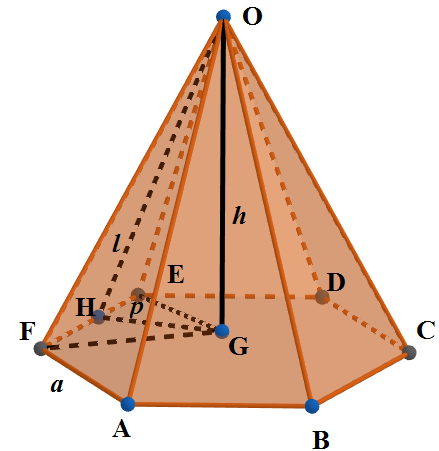
How do you calculate the surface area of the lateral faces of a regular hexagonal pyramid that has a slant height of 35 cm and a base side length of 4 cm? \[\]
Answer
547.2k+ views
Hint: We recall the shape of a regular hexagonal pyramid which has lateral faces in congruent triangular shape. We find the area of one triangular base and multiply 6 to get the answer. We find the area of one triangle as $\dfrac{1}{2}\times \text{base}\times \text{height}=\dfrac{1}{2}\times a\times l$ where $a$ is the base side length and $l$ is the slant height. \[\]
Complete step by step answer:
We know that a Pyramid is a polyhedron formed by connecting a polygonal base and a point, called the apex. Each base edge and apex form a triangle, called a lateral face. A right pyramid has its apex directly above the centroid of its base. A pyramid that has a regular polygon base is called a regular pyramid. A regular hexagonal pyramid has its base as a regular hexagon. We draw the rough figure of it below with O as the apex and ABCDEF as the base of a regular hexagonal base. \[\]

The altitude dropped from apex on the hexagon is called height of the pyramid $h=OG$ and the base side length here is $a=AB=BC=CD=DE=EF=FA$. Here $l$ is the slant height dropped from apex on one of the sides (Here OH). \[\]
The surfaces excluding the base are called lateral surfaces and in a regular pyramid they are congruent. We have 6 lateral faces in a regular hexagonal pyramid which are in triangular shape. Since they are congruent they will be of equal area. So the surface area of the lateral faces will be 6 times the area of one triangular face. \[\]
Let us observe the triangle OEH. We know that the area of one triangle is $\dfrac{1}{2}\times \text{base}\times \text{height}$. Here base is $EF=a$ and height of triangle is slant height $l=OH$. So area of triangle OEH is
\[A=\dfrac{1}{2}\times a\times l\]
The regular hexagonal pyramid has a slant height of 35 cm and a base side length of 4 cm. So we have $l=35$ cm, $a=4$cm. So area of one triangle is
\[A=\dfrac{1}{2}\times 4\times 35\]
We multiply 6 and find the surface area of all the lateral faces (LSA) as
\[\text{L}\text{.S}\text{.A}=6A=6\times \dfrac{1}{2}\times 4\times 35=3\times 4\times 35=420\text{ c}{{\text{m}}^{2}}\]
Note: We note that the altitude from the centre of the hexagon on a side (here$GH=p$) is called apothem. We can find the total surface area of the hexagonal pyramid as $3pa+3la$ where $3pa$ is the base area and $3la$ is the sum of lateral surface area. We can find the volume of the hexagonal pyramid as $V=p\times a\times h$.
Complete step by step answer:
We know that a Pyramid is a polyhedron formed by connecting a polygonal base and a point, called the apex. Each base edge and apex form a triangle, called a lateral face. A right pyramid has its apex directly above the centroid of its base. A pyramid that has a regular polygon base is called a regular pyramid. A regular hexagonal pyramid has its base as a regular hexagon. We draw the rough figure of it below with O as the apex and ABCDEF as the base of a regular hexagonal base. \[\]

The altitude dropped from apex on the hexagon is called height of the pyramid $h=OG$ and the base side length here is $a=AB=BC=CD=DE=EF=FA$. Here $l$ is the slant height dropped from apex on one of the sides (Here OH). \[\]
The surfaces excluding the base are called lateral surfaces and in a regular pyramid they are congruent. We have 6 lateral faces in a regular hexagonal pyramid which are in triangular shape. Since they are congruent they will be of equal area. So the surface area of the lateral faces will be 6 times the area of one triangular face. \[\]
Let us observe the triangle OEH. We know that the area of one triangle is $\dfrac{1}{2}\times \text{base}\times \text{height}$. Here base is $EF=a$ and height of triangle is slant height $l=OH$. So area of triangle OEH is
\[A=\dfrac{1}{2}\times a\times l\]
The regular hexagonal pyramid has a slant height of 35 cm and a base side length of 4 cm. So we have $l=35$ cm, $a=4$cm. So area of one triangle is
\[A=\dfrac{1}{2}\times 4\times 35\]
We multiply 6 and find the surface area of all the lateral faces (LSA) as
\[\text{L}\text{.S}\text{.A}=6A=6\times \dfrac{1}{2}\times 4\times 35=3\times 4\times 35=420\text{ c}{{\text{m}}^{2}}\]
Note: We note that the altitude from the centre of the hexagon on a side (here$GH=p$) is called apothem. We can find the total surface area of the hexagonal pyramid as $3pa+3la$ where $3pa$ is the base area and $3la$ is the sum of lateral surface area. We can find the volume of the hexagonal pyramid as $V=p\times a\times h$.
Recently Updated Pages
Master Class 9 Social Science: Engaging Questions & Answers for Success

Master Class 9 Science: Engaging Questions & Answers for Success

Master Class 9 English: Engaging Questions & Answers for Success

Master Class 9 Maths: Engaging Questions & Answers for Success

Master Class 11 Economics: Engaging Questions & Answers for Success

Master Class 11 English: Engaging Questions & Answers for Success

Trending doubts
Which places in India experience sunrise first and class 9 social science CBSE

Fill the blanks with the suitable prepositions 1 The class 9 english CBSE

Write the 6 fundamental rights of India and explain in detail

Difference Between Plant Cell and Animal Cell

What is the Full Form of ISI and RAW

Golden Revolution is related to AFood production BOil class 9 social science CBSE




